2006 SUBARU IMPREZA tow
[x] Cancel search: towPage 290 of 365
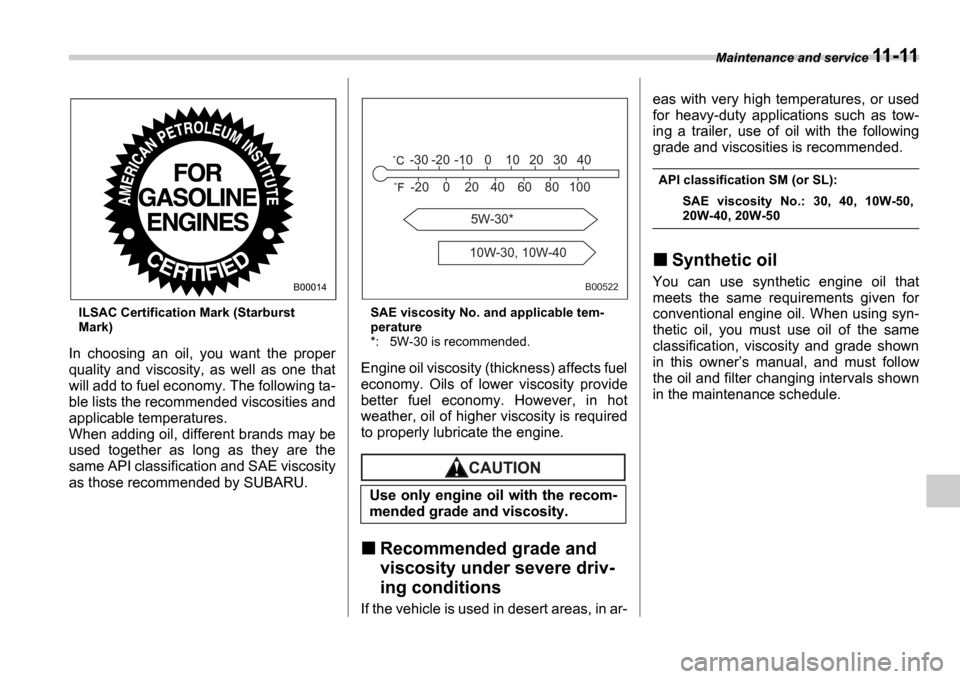
Maintenance and service 11-11
ILSAC Certification Mark (Starburst
Mark)
In choosing an oil, you want the proper
quality and viscosity, as well as one that
will add to fuel economy. The following ta-
ble lists the recommended viscosities and
applicable temperatures.
When adding oil, different brands may be
used together as long as they are the
same API classification and SAE viscosity
as those recommended by SUBARU.
SAE viscosity No. and applicable tem-
perature
*: 5W-30 is recommended.
Engine oil viscosity (thickness) affects fuel
economy. Oils of lower viscosity provide
better fuel economy. However, in hot
weather, oil of higher viscosity is required
to properly lubricate the engine.
Recommended grade and
viscosity under severe driv-
ing conditions
If the vehicle is used in desert areas, in ar- eas with very high temperatures, or used
for heavy-duty applications such as tow-
ing a trailer, use of oil with the following
grade and viscosities is recommended.
API classification SM (or SL):
SAE viscosity No.: 30, 40, 10W-50,
20W-40, 20W-50
Synthetic oil
You can use synthetic engine oil that
meets the same requirements given for
conventional engine oil. When using syn-
thetic oil, you must use oil of the same
classification, viscosity and grade shown
in this owner s manual, and must follow
the oil and filter changing intervals shown
in the maintenance schedule.B00014
Use only engine oil with the recom-
mended grade and viscosity.
B00522
5W-30*
10W-30, 10W-40
-30 -20 -10 0 10 20 30 40
-20 0 60 20 80 10040
Page 311 of 365
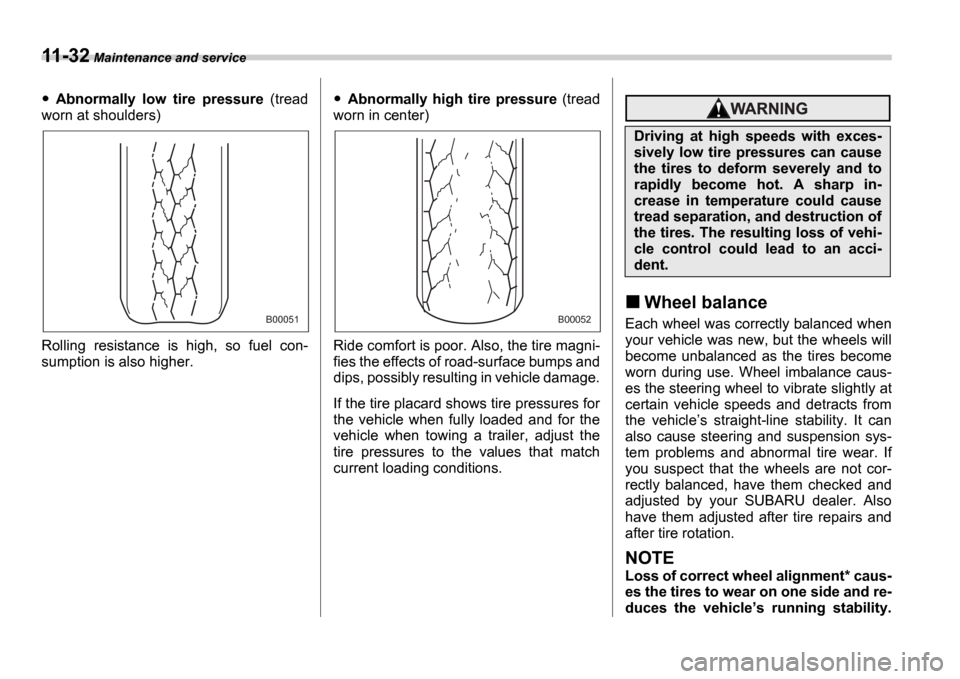
11-32 Maintenance and service
Abnormally low tire pressure (tread
worn at shoulders)
Rolling resistance is high, so fuel con-
sumption is also higher.Abnormally high tire pressure (tread
worn in center)
Ride comfort is poor. Also, the tire magni-
fies the effects of road-surface bumps and
dips, possibly resulting in vehicle damage.
If the tire placard shows tire pressures for
the vehicle when fully loaded and for the
vehicle when towing a trailer, adjust the
tire pressures to the values that match
current loading conditions.
Wheel balance
Each wheel was correctly balanced when
your vehicle was new, but the wheels will
become unbalanced as the tires become
worn during use. Wheel imbalance caus-
es the steering wheel to vibrate slightly at
certain vehicle speeds and detracts from
the vehicle s straight-line stability. It can
also cause steering and suspension sys-
tem problems and abnormal tire wear. If
you suspect that the wheels are not cor-
rectly balanced, have them checked and
adjusted by your SUBARU dealer. Also
have them adjusted after tire repairs and
after tire rotation.
NOTE
Loss of correct wheel alignment* caus-
es the tires to wear on one side and re-
duces the vehicle s running stability.
B00051B00052
Driving at high speeds with exces-
sively low tire pressures can cause
the tires to deform severely and to
rapidly become hot. A sharp in-
crease in temperature could cause
tread separation, and destruction of
the tires. The resulting loss of vehi-
cle control could lead to an acci-
dent.
Page 318 of 365
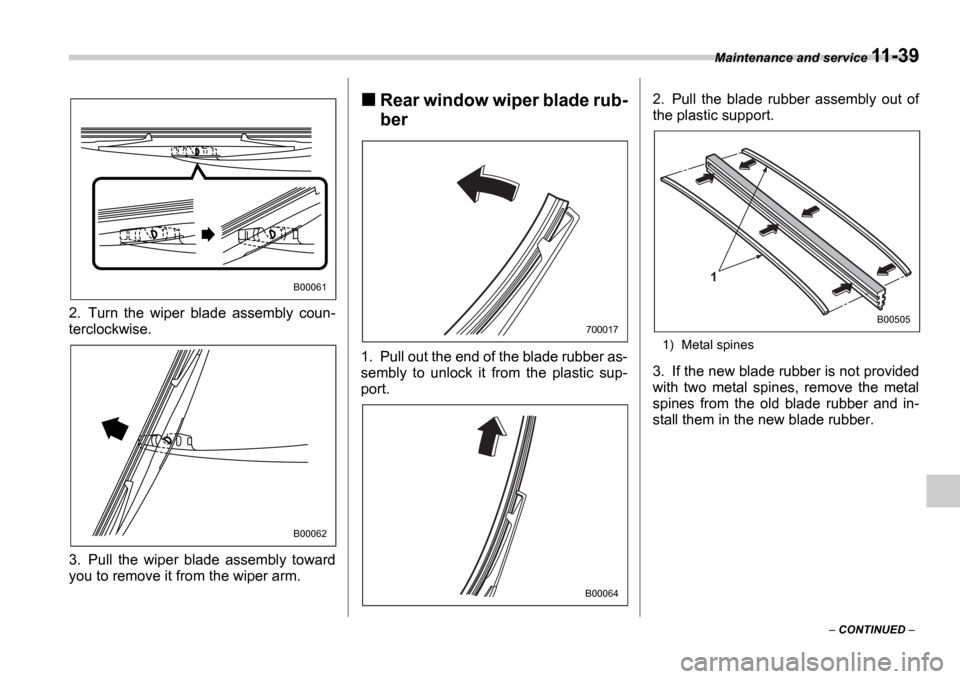
Maintenance and service 11-39
CONTINUED
2. Turn the wiper blade assembly coun-
terclockwise.
3. Pull the wiper blade assembly toward
you to remove it from the wiper arm.
Rear window wiper blade rub-
ber
1. Pull out the end of the blade rubber as-
sembly to unlock it from the plastic sup-
port.
2. Pull the blade rubber assembly out of
the plastic support.1) Metal spines
3. If the new blade rubber is not provided
with two metal spines, remove the metal
spines from the old blade rubber and in-
stall them in the new blade rubber.
B00061
B00062
700017
B00064
B00505
1
Page 349 of 365
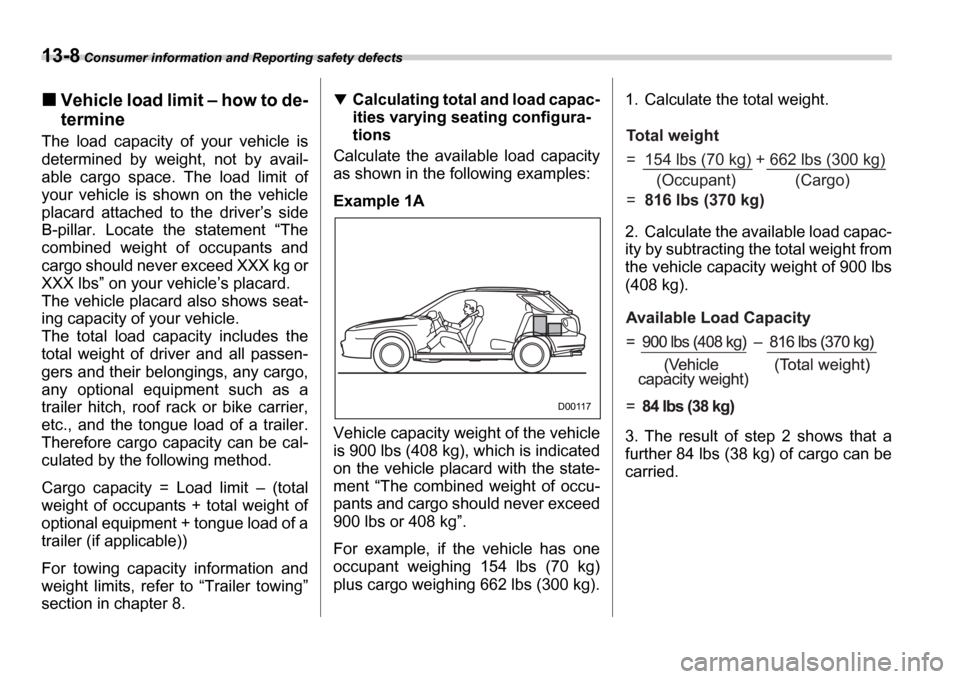
13-8 Consumer information and Reporting safety defects
Vehicle load limit how to de-
termine
The load capacity of your vehicle is
determined by weight, not by avail-
able cargo space. The load limit of
your vehicle is shown on the vehicle
placard attached to the driver s side
B-pillar. Locate the statement The
combined weight of occupants and
cargo should never exceed XXX kg or
XXX lbs on your vehicle s placard.
The vehicle placard also shows seat-
ing capacity of your vehicle.
The total load capacity includes the
total weight of driver and all passen-
gers and their belongings, any cargo,
any optional equipment such as a
trailer hitch, roof rack or bike carrier,
etc., and the tongue load of a trailer.
Therefore cargo capacity can be cal-
culated by the following method.
Cargo capacity = Load limit (total
weight of occupants + total weight of
optional equipment + tongue load of a
trailer (if applicable))
For towing capacity information and
weight limits, refer to Trailer towing
section in chapter 8.
Calculating total and load capac-
ities varying seating configura-
tions
Calculate the available load capacity
as shown in the following examples:
Example 1A
Vehicle capacity weight of the vehicle
is 900 lbs (408 kg), which is indicated
on the vehicle placard with the state-
ment The combined weight of occu-
pants and cargo should never exceed
900 lbs or 408 kg .
For example, if the vehicle has one
occupant weighing 154 lbs (70 kg)
plus cargo weighing 662 lbs (300 kg). 1. Calculate the total weight.
2. Calculate the available load capac-
ity by subtracting the total weight from
the vehicle capacity weight of 900 lbs
(408 kg).
3. The result of step 2 shows that a
further 84 lbs (38 kg) of cargo can be
carried.
D00117
Total weight
= 154 lbs (70 kg) + 662 lbs (300 kg)
=
816 lbs (370 kg)(Occupant) (Cargo)
Page 352 of 365
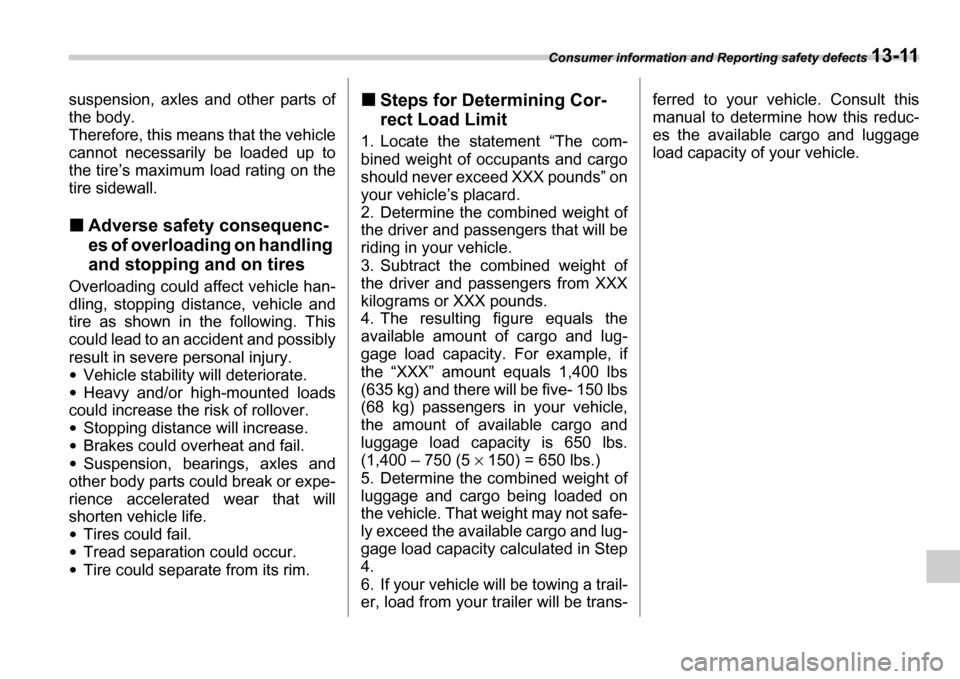
Consumer information and Reporting safety defects 13-11
suspension, axles and other parts of
the body.
Therefore, this means that the vehicle
cannot necessarily be loaded up to
the tires maximum load rating on the
tire sidewall.
Adverse safety consequenc-
es of overloading on handling
and stopping and on tires
Overloading could affect vehicle han-
dling, stopping distance, vehicle and
tire as shown in the following. This
could lead to an accident and possibly
result in severe personal injury.
Vehicle stability will deteriorate.
Heavy and/or high-mounted loads
could increase the risk of rollover.
Stopping distance will increase.
Brakes could overheat and fail.
Suspension, bearings, axles and
other body parts could break or expe-
rience accelerated wear that will
shorten vehicle life.
Tires could fail.
Tread separation could occur.
Tire could separate from its rim.
Steps for Determining Cor-
rect Load Limit
1. Locate the statement The com-
bined weight of occupants and cargo
should never exceed XXX pounds on
your vehicle s placard.
2. Determine the combined weight of
the driver and passengers that will be
riding in your vehicle.
3. Subtract the combined weight of
the driver and passengers from XXX
kilograms or XXX pounds.
4. The resulting figure equals the
available amount of cargo and lug-
gage load capacity. For example, if
the XXX amount equals 1,400 lbs
(635 kg) and there will be five- 150 lbs
(68 kg) passengers in your vehicle,
the amount of available cargo and
luggage load capacity is 650 lbs.
(1,400 750 (5
150) = 650 lbs.)
5. Determine the combined weight of
luggage and cargo being loaded on
the vehicle. That weight may not safe-
ly exceed the available cargo and lug-
gage load capacity calculated in Step
4.
6. If your vehicle will be towing a trail-
er, load from your trailer will be trans- ferred to your vehicle. Consult this
manual to determine how this reduc-
es the available cargo and luggage
load capacity of your vehicle.
Page 362 of 365

Index 14-7
Map light ......................................... ........................... 11-50
Parking light ...................................... ......................... 11-48
Rear combination lights ............................ ................. 11-48
Trunk light ........................................ .......................... 11-51
REV indicator light and buzzer ...................... ..................... 3-9
Rocking the vehicle ................................... ....................... 8-12
Roof rail and crossbar ............................... ....................... 8-14
S
Seat Fabric ............................................ ............................... 10-5
Heater ............................................ ................................ 1-5
Seatbelt .......................................... ....................................... 4
Extender ........................................... ........................... 1-19
Maintenance ........................................ ........................ 1-18
Pretensioners ....................................... ....................... 1-20
Safety tips ......................................... ............................. 1-9
Warning light and chime ............................ ......... 1-11, 3-14
Seatbelts .......................................... .................................. 1-9
Selector lever ...................................... ............................. 7-16
Position indicator .................................. ....................... 3-20
Shift lock release ................................... ........................... 7-19
Shock sensors .......................................... ........................ 2-17
Side ventilators ................................... ................................ 4-3
Snow tires ......................................... ................................ 8-10
Sounding a panic alarm ............................. ......................... 2-8
Spark plugs ......................................... ........................... 11-17
Specifications ....................................... ............................ 12-2
Speedometer ....................................... ...................... 3-6, 3-11
SRS airbag (Supplemental Restraint System
airbag) ........................................... ............................ 4, 1-35
SRS airbag system monitors ............................ ................ 1-56SRS airbag system servicing ............................
................ 1-57
SRS airbag system warning light ..................... ................. 3-15
SRS side airbag ................................... ............................. 1-51
Starting the engine ............................... ............................... 7-7
State emission testing (U.S. only) ................. ...................... 7-5
Stopping the engine ............................... ............................. 7-8
Storage compartments ................................ ....................... 6-4
Sun shades .......................................... ............................. 2-25
Sun visors ........................................... ................................ 6-3
Supplemental Restraint System airbag (SRS) ........... ....... 1-35
Synthetic leather upholstery .......................... ................... 10-5
T
Tachometer ......................................... ....................... 3-7, 3-12
Temperature gauge ................................. .................. 3-8, 3-13
Temporary spare tire ................................ .......................... 9-2
Tilt steering wheel ................................ ............................. 3-35
Tire
Chains ............................................. ............................. 8-11
Inspection ......................................... .......................... 11-30
Pressures and wear ................................... ................ 11-30
Replacement ........................................ ...................... 11-33
Rotation .......................................... ............................ 11-33
Tires .............................................. .................................... 12-4
Types ............................................... .......................... 11-30
Tires and wheels .................................... ......................... 11-30
Top tether anchorages ............................... ....................... 1-33
Towing ............................................ .................................. 9-11
All wheels on the ground ........................... ................... 9-14
Flat-bed truck ..................................... .......................... 9-13
Trailer Hitch .............................................. ............................... 8-17
Page 363 of 365
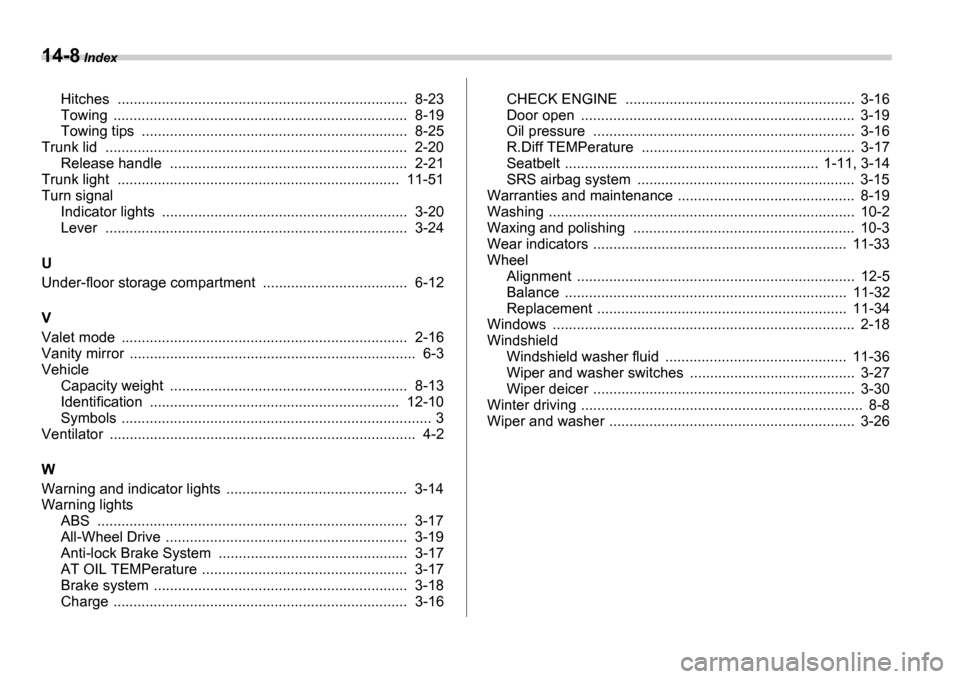
14-8 Index
Hitches ............................................. ........................... 8-23
Towing ............................................ ............................. 8-19
Towing tips ........................................ .......................... 8-25
Trunk lid .......................................... ................................. 2-20
Release handle ..................................... ...................... 2-21
Trunk light ........................................ .............................. 11-51
Turn signal
Indicator lights .................................... ......................... 3-20
Lever .............................................. ............................. 3-24
U
Under-floor storage compartment ..................... ............... 6-12
V
Valet mode ........................................ ............................... 2-16
Vanity mirror ...................................... ................................. 6-3
Vehicle Capacity weight ..................................... ...................... 8-13
Identification ..................................... ......................... 12-10
Symbols ............................................ ................................. 3
Ventilator ........................................ .................................... 4-2
W
Warning and indicator lights ........................ ..................... 3-14
Warning lights
ABS ............................................... .............................. 3-17
All-Wheel Drive .................................... ........................ 3-19
Anti-lock Brake System ................................ ............... 3-17
AT OIL TEMPerature ................................ ................... 3-17
Brake system ......................................... ...................... 3-18
Charge ............................................ ............................. 3-16CHECK ENGINE ......................................
................... 3-16
Door open ......................................... ........................... 3-19
Oil pressure ....................................... .......................... 3-16
R.Diff TEMPerature ................................ ..................... 3-17
Seatbelt .......................................... ..................... 1-11, 3-14
SRS airbag system ................................... ................... 3-15
Warranties and maintenance .......................... .................. 8-19
Washing ............................................ ................................ 10-2
Waxing and polishing .............................. ......................... 10-3
Wear indicators ..................................... .......................... 11-33
Wheel Alignment ......................................... ............................ 12-5
Balance ............................................ .......................... 11-32
Replacement ....................................... ....................... 11-34
Windows ............................................ ............................... 2-18
Windshield Windshield washer fluid ............................ ................. 11-36
Wiper and washer switches ............................. ............ 3-27
Wiper deicer ....................................... .......................... 3-30
Winter driving ..................................... ................................. 8-8
Wiper and washer ................................... .......................... 3-26